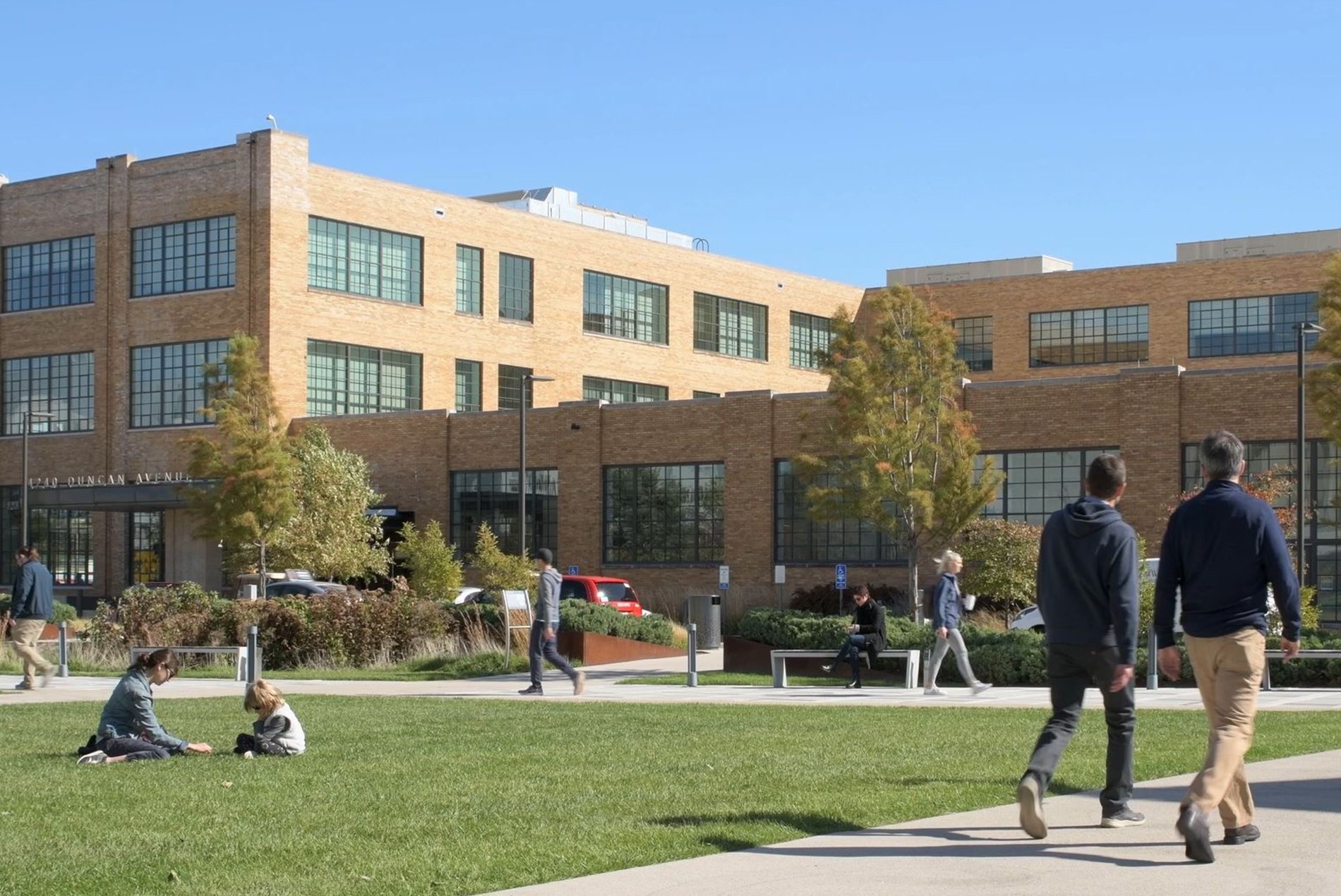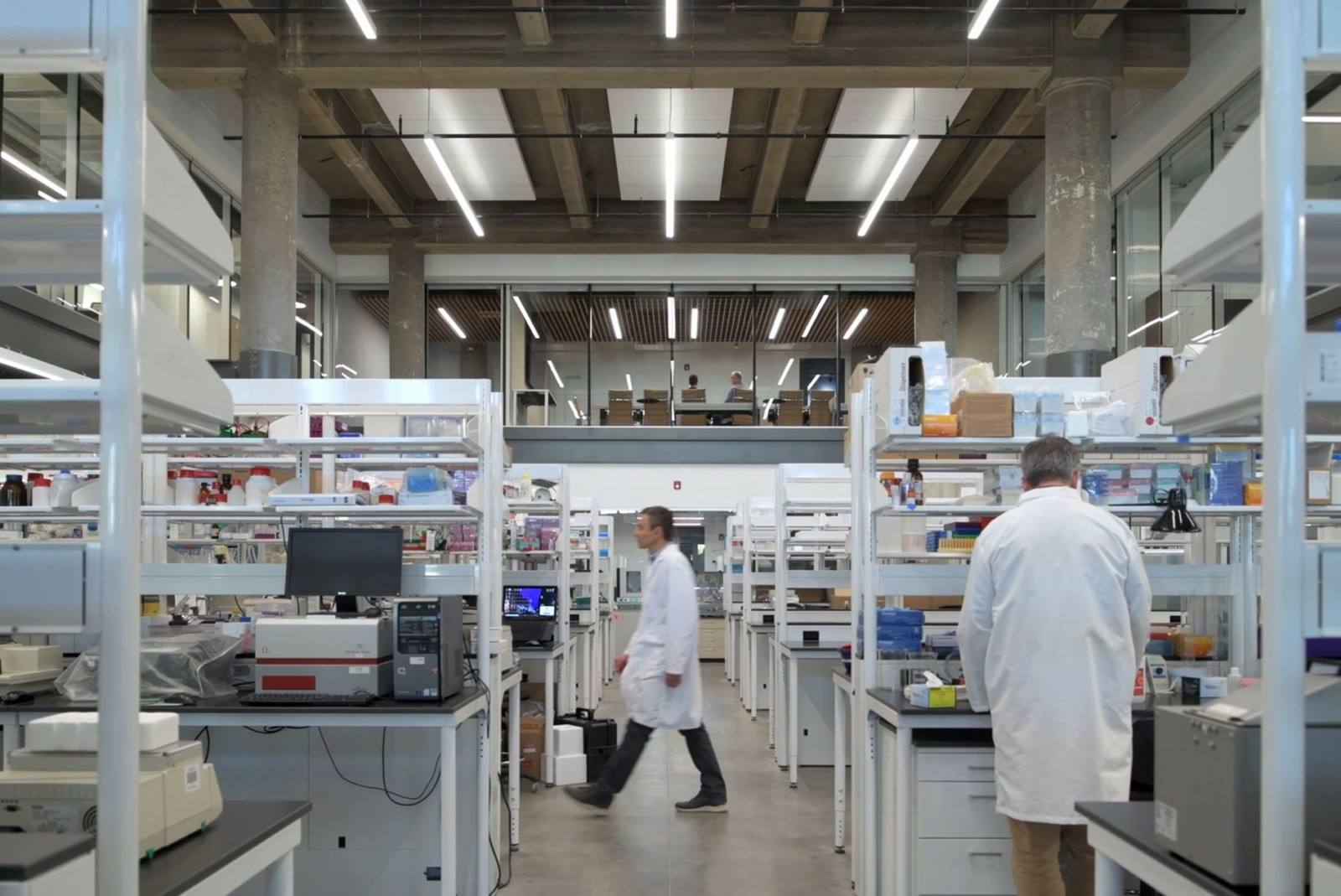HOK brought together a group of thought leaders, developers and architects to discuss the emerging science and technology sector in the Chicago region. Moderated by HOK’s Sarah Oppenhuizen and Daniel Niewoehner, the panelists talked about how organizations could contribute to this expansion and the importance of space in attracting talent.
Panelists included:
Michelle Hoffmann, Senior Vice President, Health and Life Science, P33
Alan Koder, Director of Business Development, CBRE Boston Consulting
Tim O’Connell, Director of Science + Technology, HOK
Tom Osha, Senior Vice President, Innovation and Economic Development, Wexford
Catherine Vorwald, Director of Life Sciences, Sterling Bay
Why is Chicago uniquely positioned for growth in the science and technology sector?
Tom Osha: COVID-19 has caused a reordering as we navigate recovery and attempt to restart our global economy. This plays to strengths of Chicago in three ways.
The first way is the growth of intellectual capital and research, as we see talent moving into the city and institutions like Northwestern and the University of Chicago expanding their research portfolios and initiatives.
The second is that we’re seeing an institutional de-anchoring as large organizations partner with academics, research labs and incubators. Many companies in the pharma and tech space are motivated to set up spaces close to the intellectual capital, innovation and infrastructure found in research institutions. Chicago is uniquely positioned for that.
Finally, the cost of doing business on the two coasts is becoming unsustainable—particularly as Millennials reorder their hierarchy of needs and look to settle down. They want the jobs and agglomeration of talent markets but in more affordable, livable cities.
Catherine Vorwald: There is lots of pent-up demand in Chicago. As you look at the city, every cluster has the same problem: incubators are full and there’s no multi-tenant graduation space. We’re currently working on a 55-acre mixed-use development that will be a live-work-play-grow environment connecting to bridges, a bike path, metro stop and water taxis. The first building in the life sciences portfolio in Lincoln Park—2430 N. Halsted—just broke ground and is already half leased. The demand is there. We just need the space.
What are the biggest challenges to strengthening Chicago’s position as a life sciences destination?
Tom Osha: The region has a massive spatial geography. If I drew a line between all the points of intellectual capital in the city, it would encompass 525 square miles—more than the state of Rhode Island. Innovation districts need centers of gravity that serve as hubs for research and activity. Because Chicago has been a nascent market, we haven’t had intermediaries bringing together these institutions and organizations. These intermediaries are critical. Heavily subsidized incubators also have created artificial market dynamics in Chicago. This makes it harder for companies to understand the true costs of space matriculation in life sciences.
Tim O’Connell: Lab buildings, especially for corporate life sciences, have very specific needs. You’re not going to turn Willis Tower into a lab building—it doesn’t have the right infrastructure.
Michelle Hoffmann: Chicago has great universities and academic assets. We need to do a better job translating these assets into commercial impact. My passion is developing programs that spur that growth. We have two national labs, four Tier 1 research universities, and federal research assets and funding. What we don’t have is the commercial apparatus to catalyze growth. Chicago hasn’t been first on the list for someone starting a new venture or innovation center because we haven’t had a good story to tell. Now is the time to solidify and tell our story.

How can we support and grow life sciences in Chicago?
Alan Koder: Incubators play an important role. We need to think about their role in the ecosystem, how to best support them, and how to attract and keep the talent we need. After the incubator, we need to have spaces to support these companies as they grow and transition.
Michelle Hoffmann: Space is an obvious need for Chicago. We’re behind and development venture groups take on more risk when going to a market where there isn’t certainty. One way to mitigate that risk is through public investment, which we’ve seen in Massachusetts, Texas and California. But if public money isn’t available, there needs to be movement toward raising private funds and foundation money to catalyze growth. We must have enough resources to help organizations understand that we have already made the investment and just need their talent.
Catherine Vorwald: The most urgent need is to have more space for organizations, incubators and people. I was recently asked by a reporter if I was saying, “If you build it, they will come?” I clarified that to, “If we don’t build it, they’ll leave for sure.”
Alan Koder: Part of the reason space is so important is that when a company receives a significant round of financing, they have to move quickly to execute. They have milestones to achieve and need to immediately put that capital to work. They can’t wait 12 months for a space to be designed and built. That’s lost time and money. Most of these companies have similar needs: 15,000 to 30,000 square feet of lab space with built-in flexibility. But we also need building owners to be flexible. Successful companies outgrow their spaces quickly and don’t want to sign long-term leases. Less aggressive lease terms attract early-stage companies.
Tom Osha: The city needs to focus on understanding its comparative differentiations. Are there companies it wants to draw closer to for its cell and gene therapy? Or large molecule therapeutics? Or personalized medicine? Honing in on an area of expertise can help solidify the city’s position as a destination for the sciences.
How are developers in Chicago addressing this need for turnkey space and grad labs?
Catherine Vorwald: Some of our buildings in other sectors of our portfolio are designed for one tenant. For the life sciences, we need to be looking at how we can quickly and efficiently transform spaces into multi-tenant buildings. The demand is there but spaces need to be flexible and right-sized.
Tim O’Connell: Developers understand performance and value propositions. They know how to make spaces attractive and affordable for tenants who are graduating into these corporate leased spaces. They consider how a building can flex and change over time. A building’s mechanical, electrical and plumbing system must be able to accommodate a phased move-in of tenants. Developers need to be smart about investing in infrastructure in phases and deploying strategies that are efficient and that minimize upfront costs.
Tom Osha: Driving quick growth requires resource concentration for capital efficiency. An incubator is heavily subsidized. You are getting mentorship, business advice and even access to shared equipment and resources. When these innovators graduate, it can be a shock. They still need highly collaborative environments and connections to larger companies. We need bio labs designed to accommodate this highly serviced environment after the incubator phase. Having lab spaces that people can graduate to almost overnight will ensure we don’t slow the innovation process.
What can Chicago do to entice companies to relocate here?
Alan Koder: As Tom mentioned, the city needs to hone in on an area of focus. If we try to do everything great or everything at once, we end up doing nothing really well. We should evaluate the current industries in the city and determine how life sciences could leverage or intersect with them. We also need to design buildings for the next generation. Our buildings play an important role in creating energy and excitement among future talent and can encourage them to pursue careers in the life sciences.
Michelle Hoffmann: We need to show that there is something in Chicago that business owners and entrepreneurs can’t get anywhere else. When people are looking for innovation, they are looking for talent. They assign value based on whether they can find the talent and amenities they need somewhere else. We need to promote all that we have to offer in Chicagoland and show we can do it better than any city.
Catherine Vorwald: Both the mayor and governor’s strategic plans prioritize life sciences and healthcare. But the city needs all the various stakeholders to collaborate. Organizations like World Business Chicago are integral to drawing attention to the city as a great place to live, work, play and grow.
